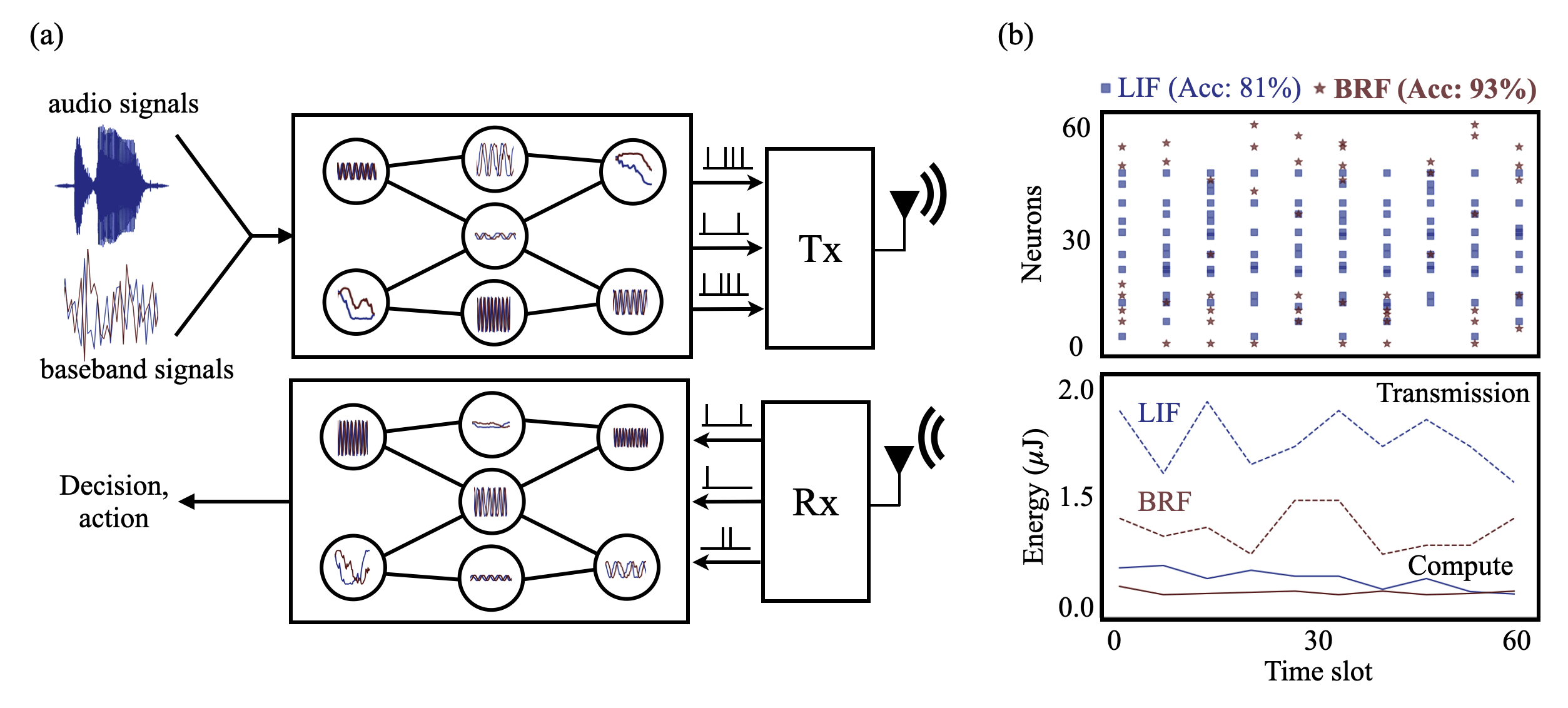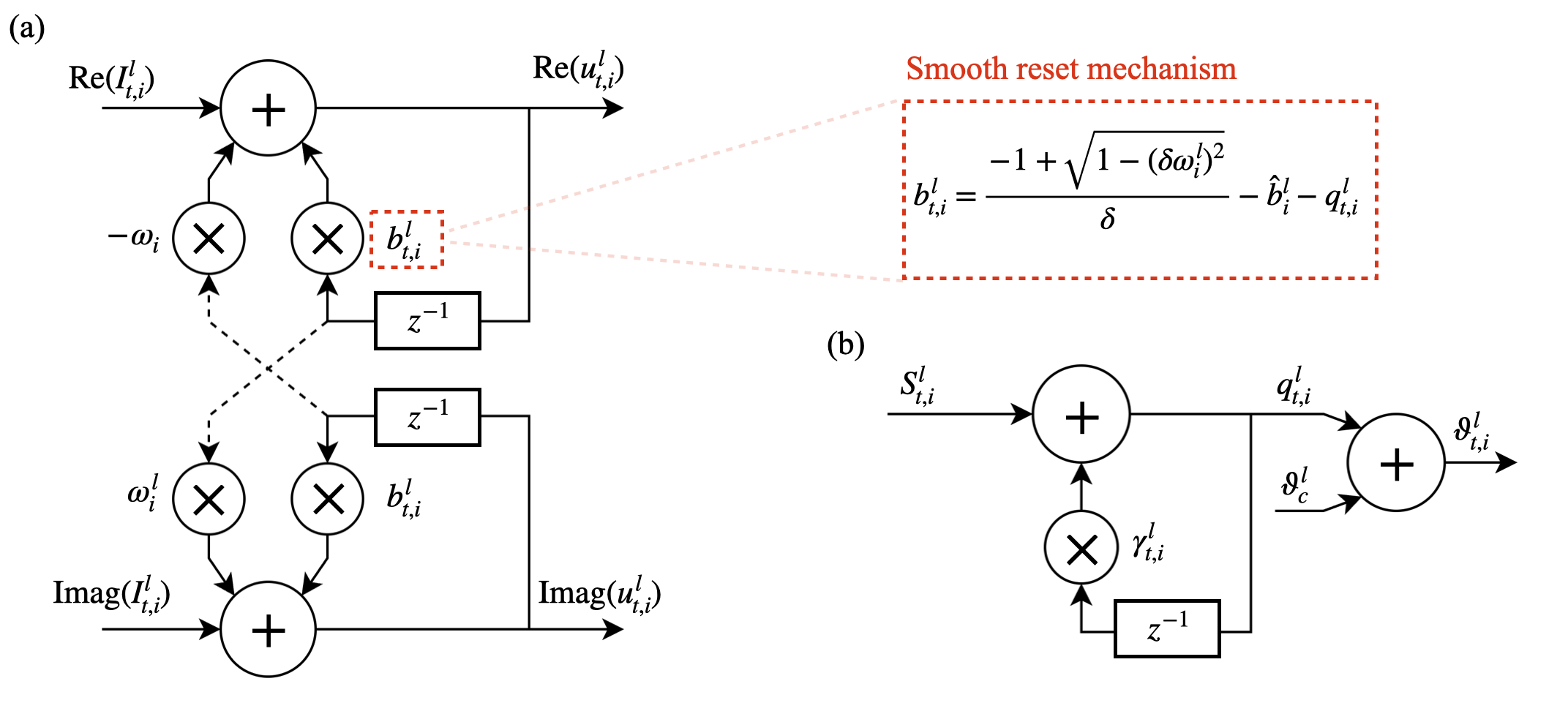- The paper proposes a neuromorphic split computing architecture that leverages resonate-and-fire neurons for efficient, event-driven processing of wireless signals.
- Results demonstrate that BRF neurons achieve competitive accuracy with significantly reduced transmission and computation energy compared to LIF models.
- The system employs OFDM-based spike mapping and regularization techniques for sparsity, enhancing energy efficiency in edge computing.
Neuromorphic Wireless Split Computing with Resonate-and-Fire Neurons
Introduction
The paper "Neuromorphic Wireless Split Computing with Resonate-and-Fire Neurons" investigates a novel approach to edge computing in wireless environments, utilizing resonate-and-fire (RF) neurons. Neuromorphic computing leverages spiking neural networks (SNNs) which operate through event-driven computation. RF neurons provide oscillatory dynamics, capturing time-localized spectral features natively, thereby eliminating the need for preliminary spectral pre-processing typically required by traditional spiking models such as the leaky integrate-and-fire (LIF) neurons.

Figure 1: Neuromorphic wireless split computing architecture based on RF-SNNs: (a) The transmitter acquires time-domain signals with informative spectral components, such as audio or baseband (radio) signals.
Resonate-and-Fire Spiking Neural Network
RF neurons are introduced to support the processing of streaming time-domain signals. Such neurons are capable of resonating at preferred frequencies, acting as biological band-pass filters that accumulate input oscillations to produce spikes when input frequencies align with the neuron’s own natural resonance frequency.
This approach builds on previously introduced balanced RF (BRF) models which incorporate adaptive refractory mechanisms to adjust spiking activity while maintaining memory of previous inputs. These enhanced BRF models ensure temporal sparsity, reducing both computation and transmission energy considerably compared to LIF neurons.

Figure 2: Illustration of the dynamic of the BRF neuron (b^=15) when the input is a sinusoid with frequency 188.50 rad/s.
Split Computing Architecture
The proposed architecture partitions the SNN across a transmitter and a receiver, mediated by a wireless link using orthogonal frequency-division multiplexing (OFDM). The transmitter processes streaming signals into spike events, each mapped onto OFDM subcarriers, allowing real-time communication despite constraints in energy usage.
This setup reduces the number of transmitted spikes due to resonance-driven sparsity, which directly translates to reduced transmit power requirements, advantageous in wireless sensor networks where energy efficiency is critical.

Figure 3: Timeline of a neuromorphic wireless split computing system.
System Design and Energy Optimization
For efficient energy usage, the system adopts regularization techniques targeting sparsity promotion during training, minimizing the spike rate in either the encoding or decoding components of the split SNN. This reduces local compute energy and transmission energy proportional to the number of spikes handled.
The system accounts for senomic operations, showcasing that traditional energy models that ignore somatic dynamics may inadequately represent the real energy consumption in such advanced neuromorphic setups, particularly when comparing the more complex BRF neuron dynamics.

Figure 4: Digital implementation schematic of the somatic operation of an ALIF neuron: (a) ALIF neuron dynamics.
Through simulation, the paper demonstrates RF-SNN models achieving competitive accuracy to conventional models while drastically reducing total energy consumption. Specifically, it was shown that RF-based SNNs achieve better sparsity-accuracy trade-offs in both audio processing using the SHD dataset and baseband signal classification using the ITS dataset.
Results indicate BRF neurons provide superior energy efficiency with competitive accuracy due to their resonant filtering, demonstrating significant reductions in compute and transmission energy.

Figure 5: Energy consumption versus accuracy for different neuron models on the SHD dataset.
Conclusion
The introduction of RF neurons in wireless split computing architectures yields promising results, significantly reducing energy consumption while maintaining competitive accuracy for real-time signal processing tasks. The inherent spectral sensitivity of RF neurons aligns well with the requirements of streaming applications encountered in wireless communications and audio recognition. Future work can explore dynamic frequency tuning within RF dynamics to adaptively respond to diverse environmental conditions.
Overall, this research contributes substantially to the field, hinting at the potential for low-energy, high-efficiency computing, meeting the tailored demands of edge AI systems in a rapidly evolving technological landscape.




